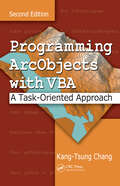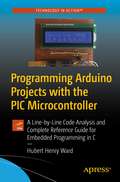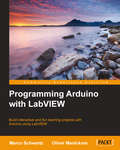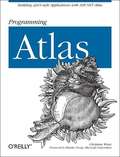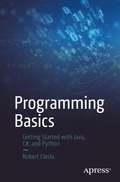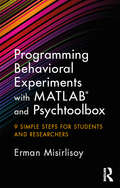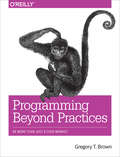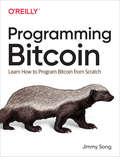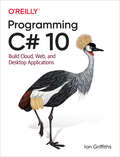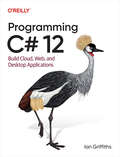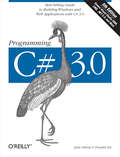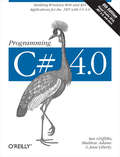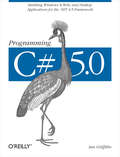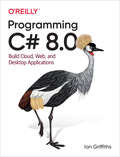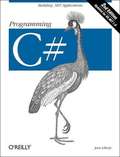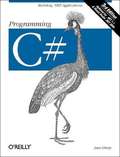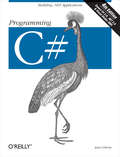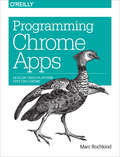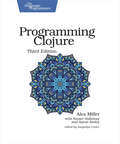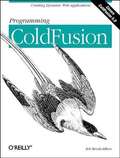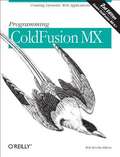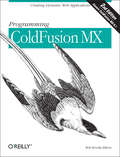- Table View
- List View
Programming ArcObjects with VBA: A Task-Oriented Approach, Second Edition
by Kang-Tsung ChangIf you're ready to take your knowledge of ArcGIS to the next level, then you need to learn how to work with ArcObjects. But with thousands of objects, properties, and methods, how can you ever hope to sort through the ArcObjects model diagrams?The first edition of Chang's Programming ArcObjects with VBA: A Task-Oriented Approach gave us the answer. The author's task-oriented approach shows you how to sort through the massive ArcObjects collection by examining only the objects, properties, and methods you need to perform specific tasks.What's new in the second edition?This edition adds macros and explanations for the new Geoprocessing object introduced in ArcGIS 9.x. Instead of treating this new feature in separate chapters, the author incorporates Geoprocessing code into the existing chapters. The code appears conveniently in boxes that allow you to easily compare sample macros.Get Started with Ready-to-Use CodeThe downloadable resources contain 95 complete ArcObjects macros and 33 Geoprocessing macros, along with datasets to execute the code. Each program begins with a short usage description and a list of key properties and methods, followed by the listing and explanation of the code itself.Regardless of your programming experience, Programming ArcObjects with VBA: A Task-Oriented Approach, Second Edition gives you the key to unlock the power and versatility of using ArcObjects to help you manage GIS activities.
Programming Arduino Projects with the PIC Microcontroller: A Line-by-Line Code Analysis and Complete Reference Guide for Embedded Programming in C
by Hubert Henry WardNow that you’ve built a few Arduino projects, and reused some pre-written sketches, it’s time to move on to the next step and explore the world of embedded programming. To truly up-skill, you'll need to understand how your code works, and that's where this book comes in. You'll review and work with several Arduino projects plus two extra ones written for a PIC microcontroller. Each one is accompanied with a basic circuit diagram and photos of the program working. Ideal for the Arduino hobbyist and PIC programmers who want to merge their skills, this comprehensive book will go over every aspect of the 8-bit microcontroller, provide line-by-line analysis of the code, and in the end, show you how to bring your Arduino projects to the PIC microcontroller using C. You'll gain a full understanding of how the C instructions work and can be used with the PIC microcontroller.Programming Arduino Projects with the PIC Microcontroller is your one-stop reference resource. What You’ll LearnExamine how the code works Create code to perform any functionBuild practical projects on vero boards with full vero plans and circuit diagramsUnderstand how programs work by simulation with an ECAD package Who This Book Is ForWould-be embedded programmers, Arduino hobbyists, and PIC programmers.
Programming Arduino with LabVIEW
by Marco Schwartz Oliver ManickumIf you already have some experience with LabVIEW and want to apply your skills to control physical objects and make measurements using the Arduino sensor, this book is for you. Prior knowledge of Arduino and LabVIEW is essential to fully understand the projects detailed in this book.
Programming Atlas
by Christian WenzIn the past year, developers worldwide have embraced the Ajax combination of technologies (Asynchronous Javascript and XML) as a way to build web applications that deliver users a more desktop-like experience. Now, in an effort to simplify Ajax development, especially for ASP.NET 2.0 developers, Microsoft has introduced a new framework, code-named "Atlas", that is loaded with tools, templates and controls that simplify the creation of Ajax savvy web pages that are richer, more interactive, and more personalized, as well as standards-based and able to run cross browser. Programming Atlas Rough Cuts provides experienced web developers with an exciting hands-on tour of "Atlas," beginning with an introduction to the Ajax technologies behind it all, from JavaScript, and XMLHttpRequest to JSON. Author Christian Wenz then unpacks the "Atlas" framework and shows how to use it to create Ajax-enabled web sites. Dozens of examples demonstrate how to use core "Atlas" controls and extenders, how to bind and display data, and how to draw on the power of Microsoft Web 2.0 services such as Microsoft Virtual Earth and Windows Live. The book will be especially useful to web developers who are new to Ajax, regardless of their current platform, and its combination of well-explained examples and reference material, concisely presented, makes the concepts of this new framework accessible to developers of various technical levels. Recently updated for the April CTP release of "Atlas", the book now includes a new chapter on the shared source "Atlas" Control Toolkit!
Programming Atlas
by Christian WenzLearn how to deliver richer, more interactive web experiences to your users using ASP.NET Atlas, Microsoft's new framework for building Ajax-savvy web sites. Web developers of all persuasions have embraced the Ajax suite of technologies (JavaScript, HTTP, XML and more) as a way to implement pages that are faster, livelier and more desktop-like in their behavior. Now Atlas brings the power of Ajax to ASP.NET 2.0 developers with controls, script libraries and server support that delivers engaging results without the pain that writing complex JavaScript can entail. Better yet, Atlas web pages are standards based and even run cross-browser. Programming Atlas is not just another "drag and drop" ASP.NET 2.0 book, but dives into the technologies that make it work. You'll begin with a tour of the technologies most often associated with Ajax, from JavaScript and XMLHttpRequest to JSON and the DOM. With the fundamentals in place, author JavaScript expert Christian Wenz unpacks the Atlas framework and shows you how to put its tools to work. You'll learn to: Understand the architecture of Atlas and the role played by server conrols, such as ScriptManager and UpdatePanel Use core Atlas controls and extenders to build more interactive pages with text fields that autocomplete, user input that is validated, controls that can be dragged and dropped, and much more Bind, display, and update data without causing the entire page to refresh and use the Atlas web services bridge to consume third-party services beyond the domain of your application Incorporate Microsoft Virtual Earth into an application, use Atlas with Web Parts, and create a Windows Live Gadget Use Atlas with PHP and explore other non-Microsoft Ajax tools for ASP.NET
Programming Basics: Getting Started with Java, C#, and Python
by Robert CieslaExplore the basics of the three most popular programming languages: C#, Java, and Python and see what it's like to function in today's world from the perspective of a programmer. This book's uses is highly practical approach with numerous code listings aimed at bringing generations together through the intricacies of technology. You'll learn how understanding the basics of coding benefits non-programmers working with software developers. Those in the gaming/media industry will also benefit from understanding a programmer's point of view. The same applies to software testers and even company executives, who might have an education in business instead of computer science.What You'll LearnThink and read code-listings like a programmerGain a basic working proficiency in three popular programming languagesCommunicate more efficiently with programmers of all experience levels in a work-based environmentReview advanced OOP concepts such as exceptions and error handlingSet up your programming environments for Windows, MacOS, and LinuxWho This Book Is ForThose looking to discover programming, including beginners in all fields, and professionals looking to understand how code works.
Programming Behavioral Experiments with MATLAB and Psychtoolbox: 9 Simple Steps for Students and Researchers
by Erman MisirlisoyHuman behavior is fascinating so it’s no surprise that psychologists and neuroscientists spend their lives designing rigorous experiments to understand it. MATLAB is one of the most widely used pieces of software for designing and running behavioral experiments, and it opens up a world of quick and flexible experiment programming. This book offers a step-by-step guide to using MATLAB with Psychtoolbox to create customisable experiments. Its pocket size and simple language allow you to get straight to the point and help you to learn fast in order to complete your work in great time. In nine simple steps, it guides you all the way from setting parameters for your experiment to analysing the output. Gone are the daunting days of working through hundreds of irrelevant and complicated documents, as in this handy book, Erman Misirlisoy coaxes you in the right direction with his friendly and encouraging tricks and tips. If you want to learn how to develop your own experiments to collect and analyse behavioral data, then this book is a must-read. Whether you are a student in experimental psychology, a researcher in cognitive neuroscience, or simply someone who wants to run behavioral tasks on your friends for fun, this book will offer you the skills to succeed.
Programming Beyond Practices: Be More Than Just a Code Monkey
by Gregory T BrownWriting code is the easy part of your work as a software developer. This practical book lets you explore the other 90%—everything from requirements discovery and rapid prototyping to business analysis and designing for maintainability. Instead of providing neatly packaged advice from on high, author Gregory Brown presents detailed examples of the many problems developers encounter, including the thought process it takes to solve them.He does this in an unusual and entertaining fashion by making you the main character in a series of chapter-length stories. As these stories progress, the examples become more complex, and your responsibilities increase. Together, these stories take you on a journey that will make you question and refine the way you think about, and work on, software projects.Steps in this unique journey include:Using prototypes to explore project ideasSpotting hidden dependencies in incremental changesIdentifying the pain points of service integrationsDeveloping a rigorous approach towards problem-solvingDesigning software from the bottom upData modeling in an imperfect worldGradual process improvement as an antidote for over-commitmentThe future of software development
Programming Bitcoin: Learn How to Program Bitcoin from Scratch
by Jimmy SongDive into Bitcoin technology with this hands-on guide from one of the leading teachers on Bitcoin and Bitcoin programming. Author Jimmy Song shows Python programmers and developers how to program a Bitcoin library from scratch. You’ll learn how to work with the basics, including the math, blocks, network, and transactions behind this popular cryptocurrency and its blockchain payment system.By the end of the book, you'll understand how this cryptocurrency works under the hood by coding all the components necessary for a Bitcoin library. Learn how to create transactions, get the data you need from peers, and send transactions over the network. Whether you’re exploring Bitcoin applications for your company or considering a new career path, this practical book will get you started.Parse, validate, and create bitcoin transactionsLearn Script, the smart contract language behind BitcoinDo exercises in each chapter to build a Bitcoin library from scratchUnderstand how proof-of-work secures the blockchainProgram Bitcoin using Python 3Understand how simplified payment verification and light wallets workWork with public-key cryptography and cryptographic primitives
Programming C# 10: Build Cloud, Web, and Desktop Applications
by Ian GriffithsC# is undeniably one of the most versatile programming languages available to engineers today. With this comprehensive guide, you'll learn just how powerful the combination of C# and .NET can be. Author Ian Griffiths guides you through C# 10.0 and .NET 6 fundamentals and techniques for building cloud, web, and desktop applications.Designed for experienced programmers, this book provides many code examples to help you work with the nuts and bolts of C#, such as generics, LINQ, and asynchronous programming features. You'll get up to speed on .NET 6 and the latest C# 9.0 and 10.0 additions, including records, enhanced pattern matching, and new features designed to remove "ceremony" to improve productivity.Understand how .NET has changed in the most recent releases, and learn what it means for application developmentSelect the most appropriate C# language features for any taskLearn when to use the new features and when to stick with older onesExamine the range of functionality available in .NET's class librariesLearn how you can apply these class libraries to practical programming tasksExplore numerous small additions to .NET that improve expressiveness"Unlike books that focus on Visual Studio and technologies that interact with C#, this one covers the core language, and mastery of this core is essential to successfully building good software. It covers important concepts followed by generous code examples to explain them. It's thorough, detailed, and gets at the nooks and crannies of the language rarely covered elsewhere. It's a complete course on C#."--Jeremy MorganSoftware/DevOps EngineerIan Griffiths has worked in various aspects of computing, including computer networking, embedded real-time systems, broadcast television systems, medical imaging, and all forms of cloud computing. Ian is a Technical Fellow at endjin, and a Microsoft MVP in Developer Technologies. He's the author of several O'Reilly books and has written courses on Windows Presentation Foundation (WPF) and TPL Tables. Technology brings him joy.
Programming C# 12: Build Cloud, Web, and Desktop Applications
by Ian GriffithsC# is undeniably one of the most versatile programming languages available to engineers today. With this comprehensive guide, you'll learn just how powerful the combination of C# and .NET can be. Author Ian Griffiths guides you through C# 12.0 and .NET 8 fundamentals and techniques for building cloud, web, and desktop applications.Designed for experienced programmers, this book provides many code examples to help you work with the nuts and bolts of C#, such as generics, LINQ, and asynchronous programming features. You'll get up to speed on .NET 8 and the latest C# 11.0 and 12.0 additions, including generic math, new polymorphism options, enhanced pattern matching, and new features designed to improve productivity.This book helps you:Understand how .NET has changed in recent releases and learn what it means for application developmentSelect the appropriate C# language features for any taskLearn when to use the new features and when to stick with older onesExamine the range of functionality in .NET's class librariesApply these class libraries to practical programming tasksExplore numerous small additions to .NET that improve expressiveness
Programming C# 3.0
by Jesse Liberty Donald XieWritten by popular author and .NET expert Jesse Liberty, this thoroughly updated tutorial for beginning to intermediate programmers covers the latest release of Microsoft's popular C# language (C# 3.0) and the newest .NET platform for developing Windows and web applications. Our bestselling Programming C# 3.0, now in its fifth edition, is a world-class tutorial that goes well beyond the documentation otherwise available. Liberty doesn't just teach C#; he tells the complete story of the C# language and how it integrates with all of .NET programming, so that you can get started creating professional quality web and Windows applications. This book:Provides a comprehensive tutorial in C# and .NET programming that also serves as a useful reference you'll want by your side while you're working Covers all of the new features of the language, thoroughly integrated into every chapter, rather than tacked on at the end Provides insight into best practices and insight into real world programming by a professional programmer who worked with C# as an independent contractor for nearly a decade before joining Microsoft as a Senior Program Manager Every chapter in this book has been totally revised, and the entire book has been reorganized to respond to the significant changes in the language Full coverage, from the ground up of LINQ (Language Integrated Query) and other C# 3.0 language innovations to speed up development tasks Explains how to use C# in creating Web Applications as well as Windows Applications, using both the new Windows Presentation Foundation (WPF) and the older WinForms technology This new edition of Programming C# 3.0 is for working programmers who want to develop proficiency in Microsoft's most important language. No prior .NET experience is required for you to get started. There's no time like the present to work with C# -- and no book like this one to teach you everything you need to know. Special note to VB6 and Java programmers: if you've decided to transition to .NET, this book will take you there.
Programming C# 3.0, 5th Edition
by Jesse Liberty Donald XieWritten by popular author and .NET expert Jesse Liberty, this thoroughly updated tutorial for beginning to intermediate programmers covers the latest release of Microsoft's popular C# language (C# 3.0) and the newest .NET platform for developing Windows and web applications.Our bestselling Programming C# 3.0, now in its fifth edition, is a world-class tutorial that goes well beyond the documentation otherwise available. Liberty doesn't just teach C#; he tells the complete story of the C# language and how it integrates with all of .NET programming, so that you can get started creating professional quality web and Windows applications.This book:Provides a comprehensive tutorial in C# and .NET programming that also serves as a useful reference you'll want by your side while you're workingCovers all of the new features of the language, thoroughly integrated into every chapter, rather than tacked on at the endProvides insight into best practices and insight into real world programming by a professional programmer who worked with C# as an independent contractor for nearly a decade before joining Microsoft as a Senior Program ManagerEvery chapter in this book has been totally revised, and the entire book has been reorganized to respond to the significant changes in the languageFull coverage, from the ground up of LINQ (Language Integrated Query) and other C# 3.0 language innovations to speed up development tasksExplains how to use C# in creating Web Applications as well as Windows Applications, using both the new Windows Presentation Foundation (WPF) and the older WinForms technologyThis new edition of Programming C# 3.0 is for working programmers who want to develop proficiency in Microsoft's most important language. No prior .NET experience is required for you to get started. There's no time like the present to work with C# -- and no book like this one to teach you everything you need to know.Special note to VB6 and Java programmers: if you've decided to transition to .NET, this book will take you there.
Programming C# 4.0: Building Windows, Web, and RIA Applications for the .NET 4.0 Framework (Animal Guide)
by Matthew Adams Jesse Liberty Ian GriffithsWith its support for dynamic programming, C# 4.0 continues to evolve as a versatile language on its own. But when C# is used with .NET Framework 4, the combination is incredibly powerful. This bestselling tutorial shows you how to build web, desktop, and rich Internet applications using C# 4.0 with .NET's database capabilities, UI framework (WPF), extensive communication services (WCF), and more.In this sixth edition, .NET experts Ian Griffiths, Matthew Adams, and Jesse Liberty cover the latest enhancements to C#, as well as the fundamentals of both the language and framework. You'll learn concurrent programming with C# 4.0, and how to use .NET tools such as the Entity Framework for easier data access, and the Silverlight platform for browser-based RIA development.Learn C# fundamentals, such as variables, flow control, loops, and methodsBuild complex programs with object-oriented and functional programming techniquesProcess large collections of data with the native query features in LINQCommunicate across networks with Windows Communication Foundation (WCF)Learn the advantages of C# 4.0's dynamic language featuresBuild interactive Windows applications with Windows Presentation Foundation (WPF)Create rich web applications with Silverlight and ASP.NET
Programming C# 5.0: Building Windows 8, Web, and Desktop Applications for the .NET 4.5 Framework
by Ian Griffiths<p>C# has become one of the most versatile programming languages available. With this comprehensive guide, you’ll learn just how powerful the combination of C# 5.0 and .NET 4.5 can be. Author Ian Griffiths guides you through C# 5.0 fundamentals and teaches you techniques for building web and desktop applications, including Windows 8-style apps.</p>
Programming C# 8.0: Build Cloud, Web, and Desktop Applications
by Ian GriffithsC# is undeniably one of the most versatile programming languages available to engineers today. With this comprehensive guide, you’ll learn just how powerful the combination of C# and .NET can be. Author Ian Griffiths guides you through C# 8.0 fundamentals and techniques for building cloud, web, and desktop applications.Designed for experienced programmers, this book provides many code examples to help you work with the nuts and bolts of C#, such as generics, LINQ, and asynchronous programming features. You’ll get up to speed on .NET Core and the latest C# 8.0 additions, including asynchronous streams, nullable references, pattern matching, default interface implementation, ranges and new indexing syntax, and changes in the .NET tool chain.Discover how C# supports fundamental coding features, such as classes, other custom types, collections, and error handlingLearn how to write high-performance memory-efficient code with .NET Core’s Span and Memory typesQuery and process diverse data sources, such as in-memory object models, databases, data streams, and XML documents with LINQUse .NET’s multithreading features to exploit your computer’s parallel processing capabilitiesLearn how asynchronous language features can help improve application responsiveness and scalability
Programming C#, 2nd Edition
by Jesse LibertyThe first part of Programming C#, 2nd Editionintroduces C# fundamentals, then goes on to explain the development of desktop and Internet applications, including Windows Forms, ADO.NET, ASP.NET (including Web Forms), and Web Services. Next, this book gets to the heart of the .NET Framework, focusing on attributes and reflection, remoting, threads and synchronization, streams, and finally, it illustrates how to interoperate with COM objects.
Programming C#, 3rd Edition
by Jesse LibertyThe new edition of Programming C# focuses on the features and programming patterns that are new to the C# language and fundamental to the programming of web services and web applications on the .NET platform. Newly updated for version 1.1 of the .NET Framework and Visual Studio .NET 2003, the book features new tips and tricks plus answers to frequently asked questions about C#.
Programming C#, 4th Edition
by Jesse LibertyWith dynamic typing and many other new features, C# 4. 0 has already piqued the interest of . NET developers worldwide. This bestselling tutorial for beginning to intermediate programmers teaches you how to use the new version of the C# language to build web, desktop, and rich Internet applications with the . NET 4. 0 Framework. In this sixth edition, . NET experts Ian Griffiths and Matthew Adams cover the latest enhancements to the language, as well as the fundamentals of both C# and . NET. The book explains concurrent programming with C# 4. 0, and teaches you how to use C# with . NET tools such as the Entity Framework for easier data access, and the Silverlight platform for browser-based RIA development.
Programming C#: Building .NET Applications with C#
by Jesse LibertyThe programming language C# was built with the future of application development in mind. Pursuing that vision, C#'s designers succeeded in creating a safe, simple, component-based, high-performance language that works effectively with Microsoft's .NET Framework. Now the favored language among those programming for the Microsoft platform, C# continues to grow in popularity as more developers discover its strength and flexibility. And, from the start, C# developers have relied on Programming C# both as an introduction to the language and a means of further building their skills. The fourth edition of Programming C#--the top-selling C# book on the market--has been updated to the C# ISO standard as well as changes to Microsoft's implementation of the language. It also provides notes and warnings on C# 1.1 and C# 2.0.Aimed at experienced programmers and web developers, Programming C#, 4th Edition, doesn't waste too much time on the basics. Rather, it focuses on the features and programming patterns unique to the C# language. New C# 2005 features covered in-depth include:Visual Studio 2005GenericsCollection interfaces and iteratorsAnonymous methodsNew ADO.NET data controlsFundamentals of Object-Oriented ProgrammingAuthor Jesse Liberty, an acclaimed web programming expert and entrepreneur, teaches C# in a way that experienced programmers will appreciate by grounding its applications firmly in the context of Microsoft's .NET platform and the development of desktop and Internet applications. Liberty also incorporates reader suggestions from previous editions to help create the most consumer-friendly guide possible.
Programming Chrome Apps: Develop Cross-Platform Apps for Chrome
by Marc RochkindPut your web app design skills to work by learning how to create powerful and portable Chrome Apps. With this practical book, you’ll learn how to build Google’s unique apps to behave just like native apps so they can interact with hardware devices, access external files, and send notifications.Author Marc Rochkind takes you through a hands-on, objective tour of Chrome Apps, which run on any platform that supports the Chrome browser—including OS X, Windows, Linux, as well as Android and iOS. If you know how to work with HTML, CSS, JavaScript, and the DOM, you’re ready to get started.Learn how to build, run, and debug Chrome Apps step-by-stepUse Chrome Apps to access local files, sync files, and external filesTake advantage of key-value-pair APIs, including sync storage and IndexedDBUse WebSockets, Google Cloud Messaging, and other networking methodsDisplay graphics and images with Canvas, SVG, and the Media Galleries APIUse alarms, context menus, location, the camera, Bluetooth, USB, and other APIsPublish apps to the Chrome Web Store with the Chrome Dev Editor
Programming Clojure
by Alex Miller Stuart Halloway Aaron BedraDrowning in unnecessary complexity, unmanaged state, and tangles of spaghetti code? In the best tradition of Lisp, Clojure gets out of your way so you can focus on expressing simple solutions to hard problems. Clojure cuts through complexity by providing a set of composable tools--immutable data, functions, macros, and the interactive REPL. Written by members of the Clojure core team, this book is the essential, definitive guide to Clojure. This new edition includes information on all the newest features of Clojure, such as transducers and specs.Clojure joins the flexibility and agility of Lisp with the reach, stability, and performance of Java. Combine Clojure's tools for maximum effectiveness as you work with immutable data, functional programming, and safe concurrency to write programs that solve real-world problems.Start by reading and understanding Clojure syntax and see how Clojure is evaluated. From there, find out about the sequence abstraction, which combines immutable collections with functional programming to create truly reusable data transformation code. Clojure is a functional language; learn how to write programs in a functional style, and when and how to use recursion to your advantage. Discover Clojure's unique approach to state and identity, techniques for polymorphism and open systems using multimethods and protocols, and how to leverage Clojure's metaprogramming capabilities via macros. Finally, put all the pieces together in a real program.New to this edition is coverage of Clojure's spec library, one of the most interesting new features of Clojure for describing both data and functions. You can use Clojure spec to validate data, destructure data, explain invalid data, and generate large numbers of tests to verify the correctness of your code.With this book, you'll learn how to think in Clojure, and how to take advantage of its combined strengths to build powerful programs quickly.What You Need:Java 6 or higherClojure 1.9
Programming ColdFusion
by Rob Brooks-BilsonProgramming ColdFusioncovers everything you need to know to create effective web applications with ColdFusion, a powerful tool for rapid web site development. The book starts with the basics and quickly moves to more advanced topics, providing numerous examples of common web application tasks, so you can learn by example. Covers ColdFusion 5.0.
Programming ColdFusion MX, 2nd Edition
by Rob Brooks-BilsonThe first edition of this book has been praised as "the best reference book available on the subject." This new edition, Programming ColdFusion MX , 2nd Edition, goes even further, documenting new techniques for using ColdFusion MX 6.1 to develop and serve dynamic web page content. This exhaustive guide covers everything from the basics to advanced topics, with numerous examples that you can use for your own applications.
Programming ColdFusion MX: Creating Dynamic Web Applications
by Rob Brooks-BilsonColdFusion has enjoyed widespread use among developers as a powerful, easy-to-learn platform for creating and deploying dynamic web applications. ColdFusion's simple, tag-based language makes it easy to handle basic tasks, like processing form data and querying databases, but the language is also powerful enough to deliver highly scalable, robust applications. And now that Macromedia has integrated ColdFusion into its MX family of technologies, ColdFusion is capable of interacting with Flash MX applications, which opens up even more possibilities.The first edition of this book has been praised as "the best reference book available on the subject." This new edition, Programming ColdFusion MX, 2nd Edition, goes even further, documenting new techniques for using ColdFusion MX 6.1 to develop and serve dynamic web page content. This exhaustive guide covers everything from the basics to advanced topics, with numerous examples that you can use for your own applications. Contents include:Sharing application data using the web application framework and shared scope variablesAccessing databases, maintaining database records, and advanced database techniques such as drill-down queries, query caching, and query of queriesIntegrating applications with ColdFusion MX's new security frameworkInteracting with other data sources, including LDAP directories, email servers, and other web serversExtending ColdFusion with user-defined functions (UDFs), custom tags, and ColdFusion Components (CFCs)Advanced topics such as working with XML, consuming and producing web services, and integrating ColdFusion with Flash via Flash RemotingReference material for all the tags and functions that comprise CFML, the ColdFusion Markup LanguageProgramming ColdFusion MX, 2nd Edition, covers ColdFusion MX 6.1, the latest release of ColdFusion, and is packed with advanced strategies, insider hints, tips, and tricks for creating effective web applications. If you are a ColdFusion developer, you need this book to help you make the most out of ColdFusion MX.
